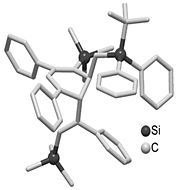The p-facial selectivity of carbonyl compounds has been at the core of synthetic organic chemistry for long time. The issue has been addressed by many individuals and many theoretical models have been proposed. We have proposed a very simple theoretical model which relies on the geometrical changes around the carbonyl group on coordination with a cation. This model has been successfully applied to many structural scaffolds.
The development of new reactions is another very important area of synthetic organic chemistry research as these allow the assembly of different skeletons with great ease. We have discovered a few new rearrangements and a few new reactions. Prominent among the rearrangements are: (i) 4,5-epoxy-2-oxepanone into 2,6-dioxabicyclo[3.3.0]octan-3-one which has been used by us in the syntheses of (+)-goniofufurone, (+)-7-epi-goniofufurone, (+)-goniopypyrone), Hagen's gland lactones and trans-kumausynes, (ii) azetidine into pyrrolidine in a stereospecific manner, and (iii) 3,3-dialkyl-2-silylmethylaze-tidine into 2-alkenyl-3-silylamines. In regard to the development of new reactions, we have made smart uses of small strained compounds and generated skeletons that are known to possess desirable biological effects.
The protocol developed for the construction of the tetrahydropyran skeleton is free from the often troubling 2-oxonia-Cope rearrangement and it thus provides an easy access to molecules like centrolobine and centrolobinetype. The protocol generating spiro-indenes from cyclopropylcarbinols may be expanded to develop optical light emitting diodes.
Our group will continue to focus on new reactions development and also the synthesis of molecules of biological interest but using only the home-grown methodologies as the key steps. Issues related to stereoselectivity arising from select structural elements will also be dealt with at theoretical levels.












